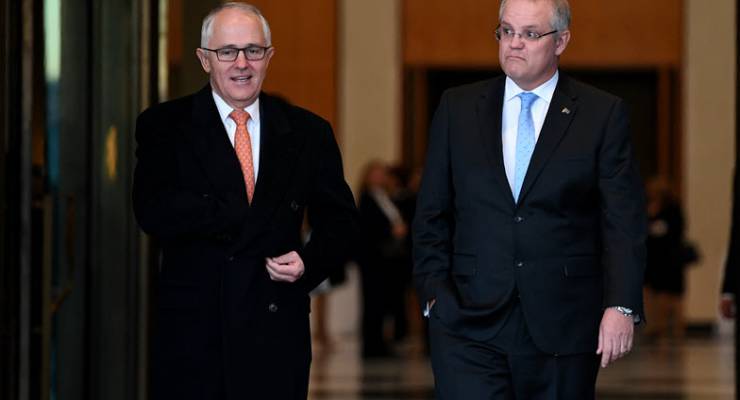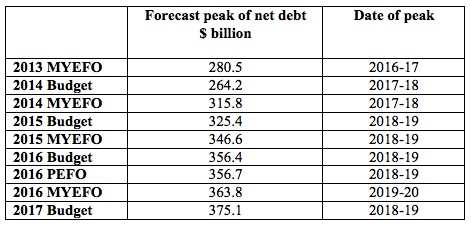
While the budget represents radical shift in rhetoric from the government and a wholehearted embrace of Labor policies across education, health, infrastructure and tax, the shift toward big government is only a continuation of the transformation of the Liberal Party that began under Tony Abbott into a party of high taxes, high debt and high spending.
When the Coalition entered government in September 2013, the independent Pre-election Economic and Fiscal Outlook produced by Treasury and Finance during the caretaker period showed that net debt was $184 billion. Their forecast was that net debt was going to peak at $219 billion in 2015-16.
But the new prime minister and his treasurer Joe Hockey had other ideas. This is how forecasts of peak net debt changed over the ensuing three and a bit years.
And while the worst blow-out was between the heroic 2014 budget and Hockey’s update six months later, when Turnbull and Morrison took over, the ever-upward debt spiral continued — and continued last night, even if debt is now forecast to peak earlier.
But that rising net debt — on which the Commonwealth will pay $15.5 billion in net interest in 2020-21 — has been accompanied by rising taxation as well. If the Howard government became debt-free in the 2000s, it became Australia’s highest-taxing government, with tax receipts reaching 24.2% of GDP in 2006. After receipts fell dramatically under Labor — to 20% in 2010 — they were at 21.4% of GDP when the Coalition arrived in office. Under Abbott and Hockey, tax receipts rose to 21.9%, then back down to 21.5% last year due to more of those pesky revenue shortfalls, but are now expected to top 22% and then surge over 23% when the 2020s arrive. High taxes are in the Liberal DNA, it seems — and they’ll be fueled by two new taxes in the budget, one on the big banks, and another increase in the Medicare levy.
The high taxes haven’t helped get debt down because Abbott’s was also a big spending government. In the last three full years of Labor, spending was consistently below 25% of GDP, even though Labor moved spending around frantically to try to get back to surplus in 2012-13. Once elected, Abbott and Hockey loaded spending into 2013-14 to make Labor look bad — but then kept on spending. As a proportion of GDP, spending reached 25.6% in 2015-16, at which point new Treasurer Scott Morrison began candidly confessing the government had a spending problem. Morrison got lucky with parameter variations reducing projected spending for major demand-driven programs, and according to last night’s budget papers spending will to drop 25.1% in this current financial year — but it will creep up again in 2017-18. And it is forecast to remain at 25% — still above the level the government inherited from Labor — in 2021.
The government argues that it hasn’t been allowed by the Senate to cut spending, but that excuse is only available to Scott Morrison in this budget, in which the government has finally abandoned its”zombie” spending cuts from the Abbott years, which has pushed the budget spending forecasts up a tad.
This is why the budget deficit remains alarmingly high — it’s still going to be $30 billion next year, five years after Joe Hockey said the Coalition would deliver a surplus in its first year and every year thereafter.
So based on the historical and forecast numbers, the Liberal Party has consistently been the party of high taxation since the Costello years. But under Abbott and Turnbull, the Liberals have become the party of high spending and high debt. It’s not just the foible of a single, inept prime minister like Tony Abbott, nor is it because Turnbull is desperate enough to shift to the centre to save his job, and it’s not the fault of the Senate. The Liberals tax more than Labor did. They spend more than Labor did. And they’re borrowing far more than Labor ever did. This is what the Liberal Party now is — the party of big government.









And this is a bad thing?
I think the bigger problem is the third apex – whilst they tax more and spend more, neither can they actually deliver anything well, preferring to ‘trust private enterprise’.
Hell, its almost arguable that increased taxation and spending is directly the amount of cost overhead privatisation continues to impact on the budget.
…But under Abbott and Turnbull, the Liberals have become the party of high spending and high debt. It’s not just the foible of a single, inept prime minister like Tony Abbott. We the Australian voting sheeples like inept, as long as there is a good slogan, we vote for inept time and again. LNP know fool them once, fool the twice, fool them thrice, fools. A good slogan and we’re in government again.
Camm makes a valid point and not just the cost overheads of fixing the holes left by privatisation but the loss of income and the distortions of social life.
Does anyone really imagine that the house price hike would have been as ludicrous had not the banks been so rapacious in their unethical lending if there had been a government owned bank?
Thanks a bunch PJK – your recent mea culpa is noted but fine words & regret butter no parsnips nor pay 6 figure deposits.
Similarly electricity prices, would the poles & wires have been gold plated had there not been the intention to make them attractive to privateers?
As for government spending on private schools & health insurance subsidies, not to mention subsidies & bribes to the likes of Adani and the gas exporters, diesel rebates and risible resource taxation, is it any wonder that people are pissed off and the situation remains unchanged?
You’ve been reading my mind AR. Well said and I note that the ALP should not be supporting 2 tier systems in any shape or form, they tend to increase and cement inequality in our ” egalitarian” land
Mr Keane, if you believe your own headline, then based on your past general support of the ALP and denigration of the Coalition, won’t you now have to change sides?
Climate change? The environment? Carbon pricing?
Or is this spend-a-thon all about preserving Turnbull and Morrison’s futures in particular?
Wash your mouth out with soap, action on climate change won’t save the boys jobs and, anyway, the nationals and Abbotts gang won’t allow it. What’s more important Mal being PM or the fate of the planet?
Hit the nail on the head